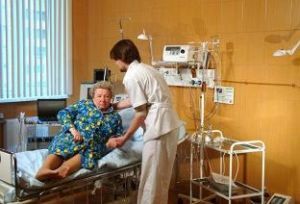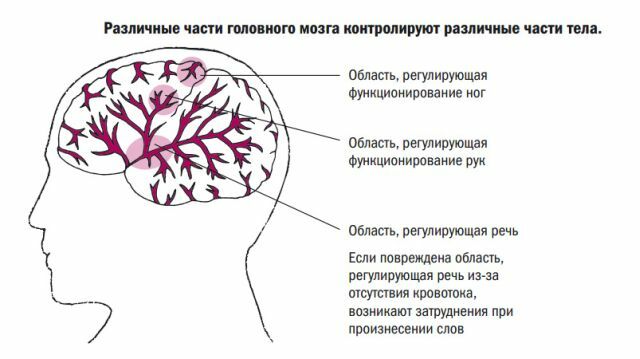At a stroke, some patients lose the ability to the pronunciation of sounds and the formulation of proposals. This effect is caused by lesions of the brain region responsible for understanding and building speech designs. Therefore speech recovery after stroke is a slow and difficult process. As remedial measures patients can take the help of a speech therapist, medical preparations and daily exercise.

Why is broken speech function
If the violation of cerebral circulation lost it, you must find out the cause of the disorder. With the loss of the capacity for speaking against the background of cerebral hemorrhage or ischemic damage to the speech center is observed in the subcortical cerebral hemispheres. It is localized in the left hemisphere of the brain in people who are fluent in the right hand. Left-handers vice versa. In some cases, speech loss occurs due to damage to the temporal, parietal, frontal lobe or the cerebellum.
With the defeat of the frontal or parietal region of a patient arises motor aphasia. The patient is not able to build complex constructions speech. In rare cases, the progressive paralysis of the vocal cords, tongue, throat and lips. Recovering it slowly. As a result, changes tone of voice, words are difficult, especially consonants.
Types of speech disorders
There are 3 main types of pathology in speech disorders after stroke: dysarthria, dyspraxia and aphasia. In some cases, developed several types of disorders.
Aphasia
From the effects of stroke aphasia is the most common type of speech disorder. With the development of disease the patient loses the ability to perceive the meaning of what was said around people forget how to read and write. In this case, there is no deterioration of cognitive functions.

Aphasia after a stroke is divided into several types:
- touch - with the progression of this type of person ceases to understand the speech of others;
- motor aphasia - a person perceives the meaning of what was said, but can not express thoughts in words;
- global or mixed is a combination of motor and sensory disorders of speech.
ataxiophemia
When brain damage can occur speech muscle weakness. In this case, disturbance of speech in stroke is called dysarthria. Pathological process does not affect speech understanding and selection of the right words. Progressive disorder causes a change of voice, lack of clarity of spoken sounds and words. May develop difficulty in breathing, in which the patient starts talking fragments of phrases. Exhaled air is not enough for the construction proposals.
dyspraxia
When dyspraxia disturbed motor skills and coordination of facial muscles and tongue muscles responsible for speech. The muscles do not move in the correct sequence, which is required to play the sounds.
It is important to understand that this is not the paralysis of the facial muscles. They are able to reduce, but do not do it in the correct order. The patient can be repeated 4-5 times 1 word to correct articulation.
How to restore speech after stroke
Combined therapy requires not only the correctness of the treatment, but also the patient's active participation. The motivation and activity of the patient depends on a 50% recovery time. The methods of recovery of aphasia and other disorders include:
- taking medication;
- stem cell therapy;
- speech therapist assistance;
- lessons at home;
- Working with a psychologist for the prevention of depression.

After speech stroke recovery takes considerable time and is a time consuming process.
Useful exercises
For efficient recovery of the speech function the patient must deal with speech therapy exercises after stroke at home. This is due to the fact that 85-90% of people suffer from sensory-motor aphasia. Therefore it is necessary to engage intensively during rehabilitation is not only an expert but also to do exercises at home.
The most effective exercises include the following techniques:
- It should be 4-5 times to hold his tongue over the surface of the upper and lower lip in a clockwise and counterclockwise.
- The lower lip is necessary to capture as much of the space of the upper lip and hold the muscles in this position for 1-2 seconds. At the end of relax facial expressions. Repeat the exercise 5-10 times required. A similar exercise should be repeated with the upper lip.
- Rounding up the language, you have to touch them to a solid, and then to the soft palate. In this case, the mouth should be closed.
- Head and neck need to pull forward. From the open mouth should be maximally push the tongue and stay in this position for 2-3 seconds. It is necessary to repeat the exercise 5-10 times.
- The language may be clicking an unlimited number of times during the day. Sound to remind the clatter of hooves.
- Twisted tube should try to stick his tongue out of the mouth.
- 5-10 times to smile so that his mouth was closed and parted lips showing dentition. Then 4-5 times a smile should be closed - lips are closed, the teeth are not visible.
- Requires stick tongue out of his mouth and emit hissing sounds like a snake hissing.
- 5-10 times to compress lip strips and hold in this position for about 5 seconds.
- I need to close my mouth. Thus between the teeth must be kept at a distance of 2 cm. Between the lips and tongue should make a circular motion clockwise and counter-clockwise.
- It is necessary to perform a kiss. In this case, you need to decompress the lips with a loud sound.
- It is necessary to put out language and try to touch their nose to the ground.

It is important to remember that exercise to restore speech after stroke at home are not intended for a single execution. During 1 admission procedures should be repeated at least 5-10 times.
Help logopedist
The period of rehabilitation with full or partial loss of speech function the patient should consult with a speech therapist. The specialist will help determine the type of disorder, and make an individual recovery plan based on existing violations. Under strict instructions logopedist 25-30% of patients with severe complications begin to speak at the time of discharge from inpatient hospital care.
To learn to speak fully, it is important to continue to engage in the rehabilitation period, and periodically consult a speech therapist to adjust the rehabilitation course. The main items of work, which is based specialist:
- observation of the patient reacting to loud sounds and whispering;
- a gradual increase and complication of exercises;
- the initial stages of treatment, the patient must understand it and try to make sounds, more later stages the patient develops the construction of complex structures of spoken - from words to sentences and texts;
- the doctor should not only be for speaking the right words, but also for understanding the meaning of words;
- expert takes into account the patient's interest in the selected category;
- the patient should continue this phrase;
- musical exercises: the patient has to sing along with your favorite songs on the text;
- painting technique: the fact that a person can not speak, he should draw.

medication
Medications prescribed only after the diagnosis and clarify the type of speech disorder. It must be remembered that the drugs do not help restore it. Drug therapy is needed to restore blood flow in the ischemic region and as a method of prevention of thrombosis:
- To prevent blood clots using blood thinning anticoagulant drugs (heparin) and thrombolytic (Aspirin).
- To improve the blood supply to the affected area nutrients administered nootropic drug.
- For the prevention of stroke recurrence are shown neuroprotective agents, antidepressants and vitamins.
Stem cell therapy
To restore blood supply to the affected area using stem cell therapy. In the course of therapy improves psycho-emotional state of the patient: the patient has a motivation to recovery, normal ability to recognize and articulate complex verbal constructions. Cell therapy is especially effective in the first few days after the defeat. The procedure is carried out for 2 courses, among which is stored in the time period of 2-3 months.

Treatment aphasia following stroke focused on vascular recovery: normal blood flow and smooth muscle endothelial work muscle disappear atherosclerotic plaques and blood clots. Observed increased vascular elasticity recovering natural wall thickness and permeability. New cerebral vessels are being built at the break.
After the 2 main courses carried out the procedure, during which updated the affected brain cells. Use of the biomaterial of the patient's spinal cord. Stem cells grown in the laboratory to the desired volume and administered intravenously for 2 treatments.
operative intervention
By resorting a surgical operation in rare cases when other methods are inefficient and do not improve the condition of the patient. The surgery is only possible with ischemic stroke. To restore the vocal apparatus a brain operation, which consists in the formation of extra-intracranial microanastomosis. During the procedure, the surgeon creates an additional connection between healthy cerebral vessel and speech brain area, without affecting the damaged areas.
As a result, the process is restored blood supply area responsible for speech. Therefore, when the voice disorders can occur improvement. Pronounced effect was observed in 75% of patients, and the risk during the operation exceeds its benefit.
How many it is restored
Terms of rehabilitation speech function depend on the area affected, the corresponding area of the brain. The stronger the ischemia, the worse the recovery process. Therefore speech after stroke in some patients may recover within a few weeks or months, while others take years of rehabilitation. In addition, possible lifelong difficulty in speaking.
The most intensive recovery lasts for the first year, after which the regeneration of neuronal connections is slowing down, and is adapting to the existing defects.



